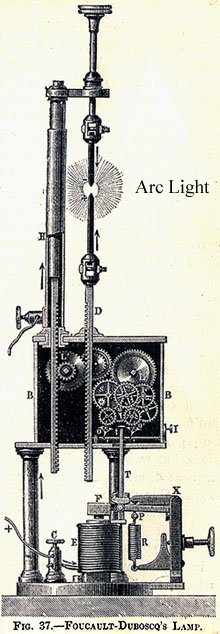The Light Electric
Today, light bulbs in 1886. The University of Houston's College of Engineering presents this series about the machines that make our civilization run, and the people whose ingenuity created them.
Julius Maier's 1886 book on Arc and Glow Lamps reminds us just how ready we were for a new technology. Electricity then created light in one of three ways. First, arc lighting: Electric current jumped a gap between two end-to-end carbon rods, creating a bright light. Second, carbon elements touched so their ends could glow brightly while they slowly burned away.
 The third way was to let electricity flow through a resistor so it glows white hot. We call that incandescent lighting. It's how almost all our light-bulbs worked -- until we began replacing them with bulbs that use fluorescent gases instead of filaments.
The third way was to let electricity flow through a resistor so it glows white hot. We call that incandescent lighting. It's how almost all our light-bulbs worked -- until we began replacing them with bulbs that use fluorescent gases instead of filaments.
Maier calls the second two kinds glow lamps, but he has a lot more to say about arc lights. Carbon-arc lights are almost gone today; but I still remember waiting in a dark movie theater. Then, a faint pop as the arc was struck in the projector and the magic could begin. Projectors still use arc lighting; but now tungsten electrodes fire in gas-filled tubes.
Incandescent lamps were about to blot out carbon arcs, just as carbon arcs were then replacing much of our oil and gas lighting. Maier recognizes the many superior features of light bulbs, but habit carries him along as he lovingly explains arc lighting.
When he traces the history of incandescent lighting, he makes no mention of Sir Humphry Davy's glowing carbon filament in 1800. But he does describe several patents for glowing platinum, iridium, and carbon in the 1840s. He tells how incandescence then lay fallow until another flurry of patents during the 1870s. Toward the end of that period, Edison gained two patents for his carbon filament lamps. British inventor Joseph Swan had made filaments of carbonized paper and demonstrated his light bulb before Edison. When Edison went commercial with his lighting system, Swan held the better patent, so Edison took him into partnership.
Maier gives tables of light-bulb performance made at the 1883 Vienna Exposition, for light bulbs of twelve inventors. Swan's bulbs hold a slight edge over Edison's, but several others had, by then, outclassed them both.
So I take in Maier's snapshot of this moment when our way of life was poised to change. In the end, he says that the glow lamp is unlikely to displace arc lighting -- that its "proper sphere of activity ... begins where that of the arc lamp ends; it is destined to furnish such smaller quantities of light which the arc lamp cannot give, and which are required for domestic purposes."
Well, he got the last part right. He's also dismayed that we're being so slow to adopt electric lighting. He finishes with an Italian saying: Chi va piano va sano e va lontano -- He who goes slowly, goes further. Well, technological revolutions are like that. Maier couldn't see just how vast and rapid the electric lighting revolution was -- or how very far it was about to take us.
I'm John Lienhard, at the University of Houston, where we're interested in the way inventive minds work.
J. Maier, Arc and Glow Lamps: A Practical Handbook on Electric Lighting. (London: Whittaker & Co., 1886). All images are from this source.
For an excellent history of the incandescent lamp, see: https://en.wikipedia.org/wiki/Incandescent_light_bulb
For more on arc lights, see: https://en.wikipedia.org/wiki/Arc_lamp
Chi va piano va sano e va lontano is often translated as the not-quite-equivalent English saying, Slow and steady wins the race. The Italian saying is about pacing one's self to stay healthy on a long journey.

Maier's images of (left) Swan's 1883 version of his light bulb, and (right) Maxim's bulb, which was actually patented by Black inventor Lewis Latimer.